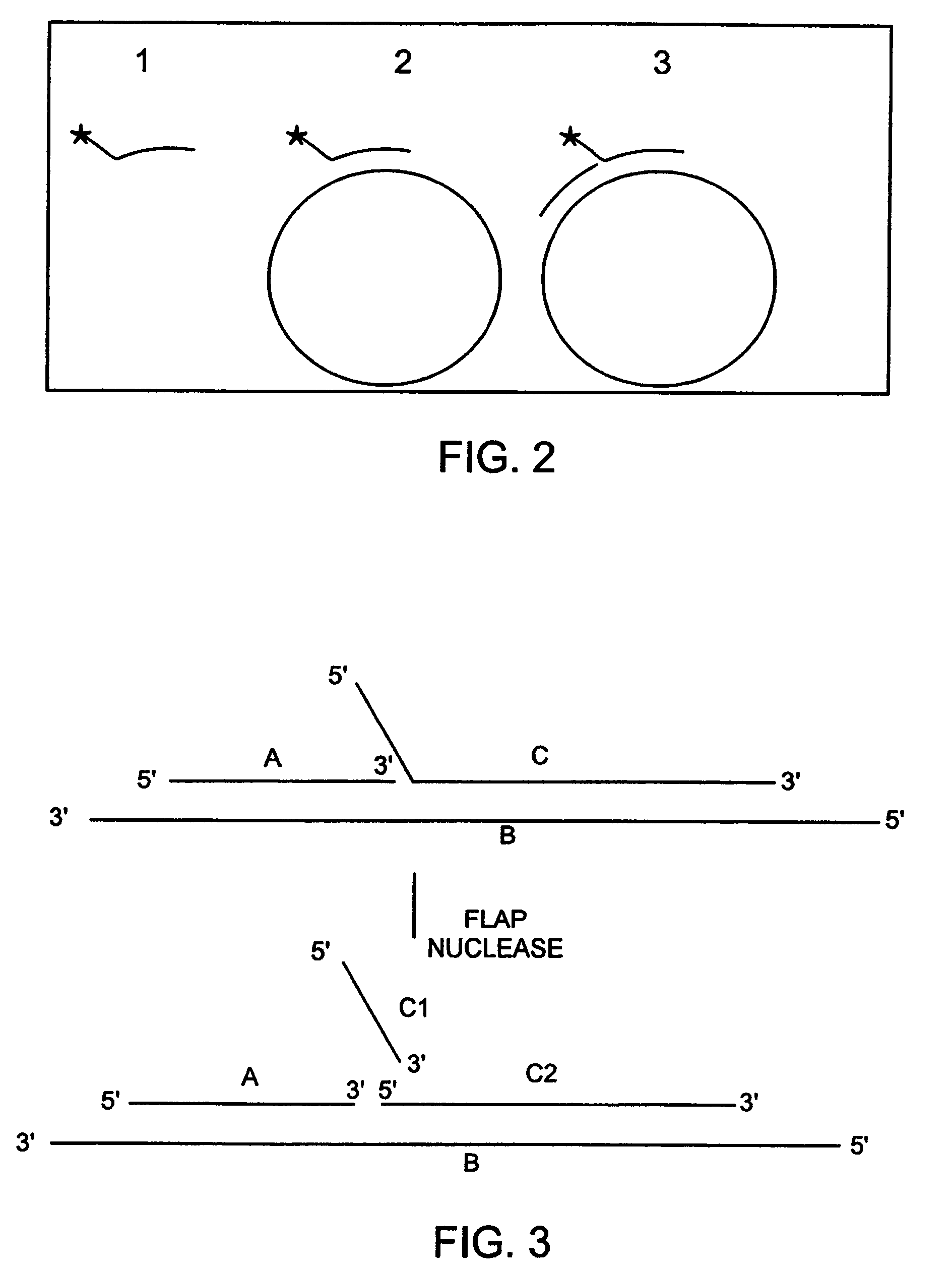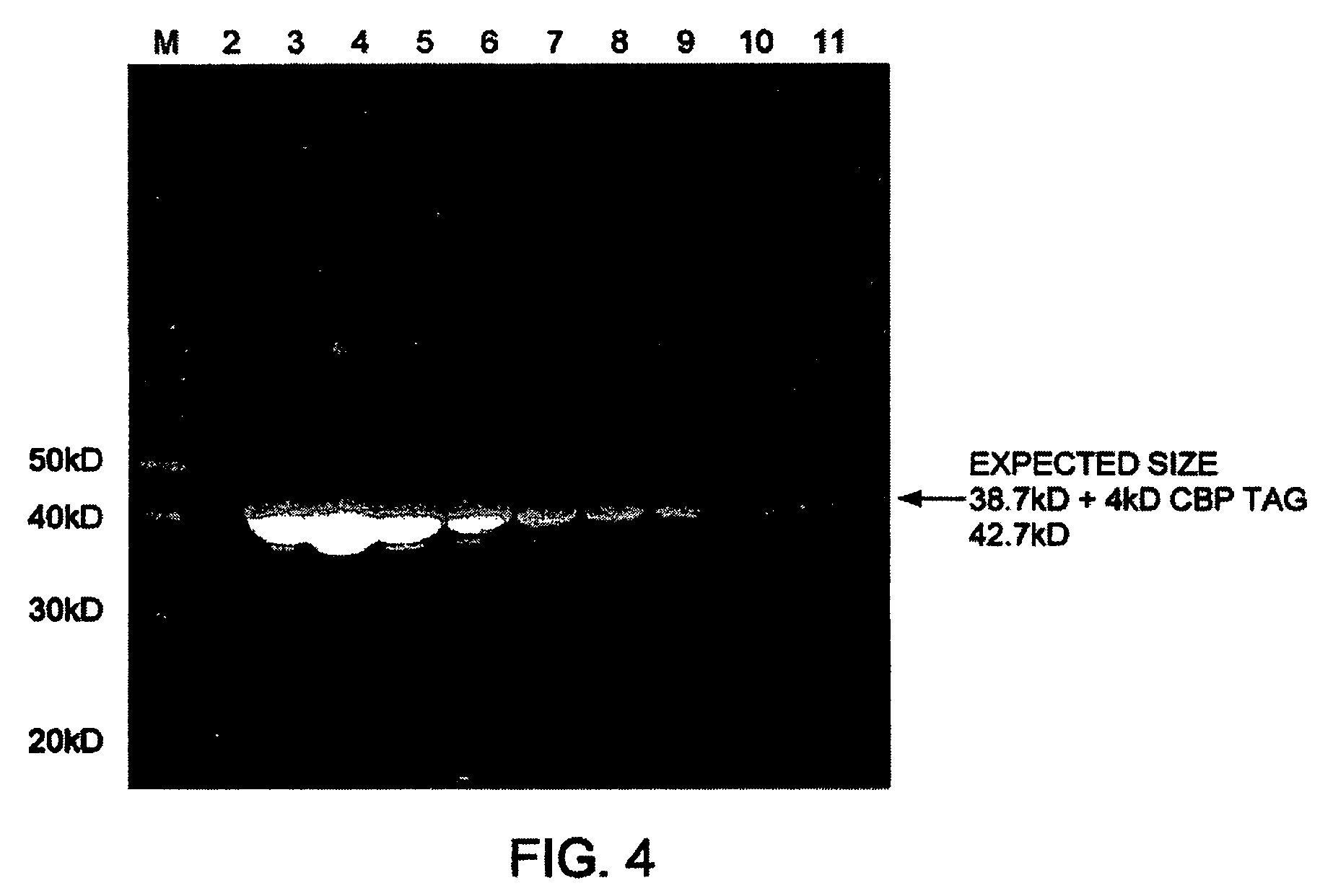Compositions and methods for the detection of a nucleic acid using a cleavage reaction
a nucleic acid and cleavage reaction technology, applied in the field of compositions and methods for the detection of nucleic acids using cleavage reactions, can solve the problems of inability to activate mutations in the poli 5′ to 3′ exonuclease domain, impair the amplification of certain nucleic acids, and require additional manipulation of amplified materials
- Summary
- Abstract
- Description
- Claims
- Application Information
AI Technical Summary
Problems solved by technology
Method used
Image
Examples
example 1
[0723]A target nucleic acid sequence can be detected and / or measured by the following method. A labeled cleavage structure is formed prior to the addition of a FEN nuclease by heating at 95° C. for 5 minutes and then cooling to approximately 50-60° C. (a) a sample containing a target nucleic acid sequence (B in FIG. 3) with (b) an upstream oligonucleotide that specifically hybridizes to the target nucleic acid sequence, (A, in FIG. 3), and (c) a downstream, 5′ end labeled oligonucleotide (C in FIG. 3) that specifically hybridizes to a region of the target nucleic acid sequence that is downstream of the hybridizing region of oligonucleotide A. A polymerase that lacks a 5′ to 3′ exonuclease activity but that possesses a 3′ to 5′ DNA synthetic activity, such as the enzyme a)Yaq exo-, (prepared by mutagenesis using the Stratagene QuikChange Site-Directed Mutagenesis kit, catalog number #200518, to modify Taq polymerase (Tabor and Richardson, 1985, Proc. Natl. Acad. Sci. USA, 82:1074)), ...
example 2
Cloning Pfu FEN-1
[0729]A thermostable FEN nuclease enzyme useful according to the invention can be prepared according to the following method.
[0730]The thermostable FEN nuclease gene can be isolated from genomic DNA derived from P. furiosus (ATCC#43587) according to methods of PCR cloning well known in the art. The cloned PfuFEN-1 can be overexpressed in bacterial cells according to methods well known in the art and described below.
[0731]The following pCAL-n-EK cloning oligonucleotides were synthesized and purified:
[0732]
a.5′GACGACGACAAGATGGGTGTCCCAATTGGTGAGATTATACCAAGAAAAG 3′ (SEQ ID NO:15)andb.5′GGAACAAGACCCGTTTATCTCTTGAACCAACTTTCAAGGGTTGATTGTTTTCCACT 3′ (SEQ ID NO:16).
[0733]The Affinity® Protein Expression and Purification System was obtained from Stratagene and used according to the manufacturer's protocols.
Amplification
[0734]The insert DNA was prepared by PCR amplification with gene-specific primers (oligonucleotides a and b, described above) that include 12 and 13-nucleotide s...
example 3
Fen Nuclease Activity
[0764]The endonuclease activity of a FEN nuclease and the cleavage structure requirements of a FEN nuclease prepared as described in Example 2 can be determined according to the methods described either in the section entitled “FEN nucleases” or below.
[0765]Briefly, three templates (FIG. 2) are used to evaluate the activity of a FEN nuclease according to the invention. Template 1 is a 5′33p labeled oligonucleotide (Heltest4) with the following sequence:
[0766]
(SEQ ID NO:1)5′AAAATAAATAAAAAAAATACTGTTGGGAAGGGCGATCGGTGCG3′.
[0767]The underlined section of Heltest4 represents the region complementary to M13mp18+. The cleavage product is an 18 nucleotide fragment with the sequence AAAATAAATAAAAAAAAT (SEQ ID NO: 2). Heltest4 binds to M13 to produce a complementary double stranded domain as well as a non-complementary 5′ overhang. This duplex forms template 2 (FIG. 2). Template 3 (FIG. 2) has an additional primer (FENAS) bound to M13 which is directly adjacent to Heltest ...
PUM
| Property | Measurement | Unit |
|---|---|---|
| pH | aaaaa | aaaaa |
| temperatures | aaaaa | aaaaa |
| temperatures | aaaaa | aaaaa |
Abstract
Description
Claims
Application Information
 Login to View More
Login to View More - R&D
- Intellectual Property
- Life Sciences
- Materials
- Tech Scout
- Unparalleled Data Quality
- Higher Quality Content
- 60% Fewer Hallucinations
Browse by: Latest US Patents, China's latest patents, Technical Efficacy Thesaurus, Application Domain, Technology Topic, Popular Technical Reports.
© 2025 PatSnap. All rights reserved.Legal|Privacy policy|Modern Slavery Act Transparency Statement|Sitemap|About US| Contact US: help@patsnap.com



